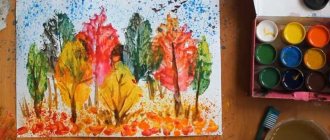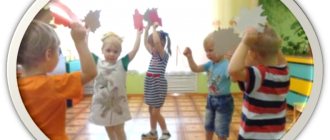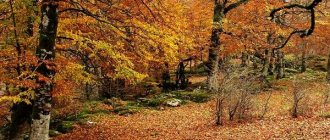Open lesson in the preparatory group of the preschool educational institution “Golden Autumn”
- October 27, 2016
Fast distance online competitions
Competition “Methodological piggy bank of a teacher”
Open lesson “Golden Autumn” in the senior preparatory group of the kindergarten. The lesson is aimed at developing cognitive and aesthetic experience, artistic taste, and a poetic ear through material related to one of the seasons - autumn.
Program content
The child and the world around him.
Natural surroundings. Environmental education
- Observe natural phenomena. Help establish cause-and-effect relationships between natural phenomena. Deepen and concretize ideas about the living conditions of plants and animals.
- Form ideas about wintering and migratory birds.
- Strengthen the ability to find and recognize wintering birds: sparrow, magpie, tit, bullfinch, etc.
- To form an aesthetic attitude towards the surrounding world. Encourage children to reflect their impressions in applications.
- Carry out vocabulary work, expanding and clarifying knowledge about the environment.
Fiction
- Continue to develop an interest in fiction.
- Help listen carefully and interestedly to stories and poems.
- Using various techniques and specially organized pedagogical situations, promote the formation of an emotional attitude towards what is perceived.
Artistic and aesthetic education
- Application
- Strengthen the ability to create images.
- Continue to develop the skills of careful and careful handling of materials.
Preliminary work:
- Looking at paintings about autumn.
- Learning poems.
Material:
- Paintings.
- Fruits, flowers.
- Portrait of autumn.
- Scissors, glue, colored paper, brushes, rags, clothescloths.
- "Tea lounge"
Progress of the lesson
Educator:
“A sad time, the charm of the eyes... Your farewell beauty is pleasant to me. I love the lush nature of withering, Forests dressed in crimson and gold. In their canopy there is noise and the first frosts and distant gray winter thunderstorms.
Now we'll talk about autumn. After what time of year does autumn come?
Children: After summer.
Educator: Name all the months of autumn.
Children: September, October, November.
Pugachev's song "Summer" is playing.
Educator: We can do something so that summer doesn’t end.
Children: You can't.
Child 1: There are 4 seasons in nature: winter, summer, spring, autumn. 12 months. Each season lasts 3 months. Everything in nature is in order: 3 months - winter, 3 months - spring, 3 months - summer, 3 months - autumn. And again all over again, because the sun heats less, not like in the summer. The days have become shorter, the sun shines less.
Educator: All seasons are good, but autumn is especially good.
Examination of paintings depicting periods of autumn.
Educator: Autumn, a festive and colorful time of year, has always pleased poets and artists. Look at the paintings, in which the artists each spoke in their own way about their love for autumn. A true artist is able to feel and understand the mood of nature - joyful or sad, jubilant or calm.
Here, look at how the artist spoke about his love for autumn in his painting.
Examination of the painting “Silence”, art. Podlaski.
Child 1: Autumn has come, the autumn wind howled and tore the yellow leaves from the trees. Leaves flew, swirled and fell to the ground in a multi-colored crimson carpet. Look, there are thin birch trees on the edge of the lake. Near the tallest birch tree there is a table and two benches. Nobody here.
Child 2: And just yesterday my grandfather and I sat on them and admired the lake, picked flowers and picked mushrooms in that green forest over there. Autumn will pass, winter will come, spring, then summer, and grandpa and I will come here again.
Examination of the painting “Evening Bells”, art. Levitan.
Educator: Now pay attention to this picture. Whose bold colors and brushes are these? Which artist brought a miracle? This is Levitan's painting "Evening Bells".
Child: There is indescribable beauty in this picture. All the trees are decorated with gold. Birch trees with long braids, wearing elegant yellow sundresses, look into the quiet river. Beautiful girlfriends are fashionable. What do you hear?
Music sounds: Bell ringing.
Child:
A blue haze looks into the eyes of the log shacks, Over the bluebell meadow the Cathedral rings its bells. The ringing of bells and roundabout, And the ringing of bells. And each bell into the soul Until new joys and strength, Your meadows ring no louder than the Bells of Your Rus'...”
Educator: Indeed, over there in the distance beyond the Kupala River you can see the bell towers of the white monastery. The bell rings at the service and calls people. How to get there? You'll have to swim across the river. The water in the river is clean, transparent, crystal - and everything is reflected in it: the trees, the banks, and the sky.
This is how artists confessed their love for autumn, and this is how Russian poets talked about their love.
Child 1 reads Pleshcheev’s poem “Autumn.”
Child 2 reads Chusovitin’s poem “Autumn Leaf.”
Educator: Many artists fell in love with autumn and painted autumn landscapes, and others painted autumn still lifes.
Child 3:
If you see in the picture Marigolds in a basket Or an aster in crystal Or a chrysanthemum in a vase Or a rose on the table Or all the objects at once - Know that this is a still life.
Child 4:
If you see in the picture a vase of fruit on the table, or a pear or a plum, or a peach to the side. Maybe you saw bunches of grapes here now Or all the fruits at once - Know that this is a still life.
Educator: Here is a living still life, and here is a still life in a painting. You look at a still life, everything on it looks like it’s alive. Ripe grapes, berry after berry. The melon is huge, ripe, yellow, oval. I really want to try it.
September flew by quickly, and October is coming to an end.
Soon white snowstorms will lift the snow from the ground. The cranes are flying away, flying away, flying away. You can’t hear the cuckoo in the grove and the birdhouse is empty. The stork flaps its wings - It flies away, it flies away.
What happens to the birds in the fall?
Children: They fly away to the south.
Educator: Many birds feed on insects, but there are none. So they fly south.
Child 1:
The leaves fly away in the fall, the grasses dry up in the swamps, the birds gather in flocks and are ready to fly away.
Child 2:
And saying goodbye to their native places, With golden birches and willows, They circle for a long time over the forests, Over steep river cliffs.
Child 3:
Come back, birds, in the spring, When the forest is clothed with greenery, Every bush and every tree will rustle with young leaves.
Educator: Autumn is flying away, the birds are flying away, but red autumn will remain in our memory for a long time. And as a memory of autumn, we will leave her portrait in sunny autumn colors.
In an autumn wreath of colorful leaves, in an autumn wreath of fragrant fruits. Let's finish the portrait and decorate our cafe with it, where currant juice with farewell autumn leaves awaits us.
Author: Ekaterina Viktorovna Pershina, teacher of the Children's Preschool Educational Institution Central District of Children's Education - Kindergarten No. 46, Apatity, Murmansk Region.
“Hello, golden autumn!”
Lesson-tour of the world around us
in 2nd grade on the topic “Hello, golden autumn!”
Completed by: Lyudmila Mikhailovna Maslennikova, primary school teacher
Target:
consolidate students’ ideas about the characteristic signs of autumn and autumn changes in nature.
Objectives:
1. Educational: to consolidate the concept of “the world around us”; expand students’ understanding of the signs of autumn; form the concept of “living” and “non-living” nature. 2. Developmental: develop the ability to observe autumn changes in nature, memory, attention, coherent speech, emotional and aesthetic responsiveness to the beauty of native nature. 3. Educational: to cultivate a respectful attitude towards each other, towards the opinions of their comrades; to cultivate a caring attitude towards nature and love for one’s native land. Progress of the lesson Guys, we have an unusual lesson today. You and I will go on a journey. Where, guess the riddle. The house is open on all sides, It is covered with a carved roof, Come into this house, You will see miracles in it! (Forest, park)
-Yes, today we will go on a trip to our city park to visit the golden autumn. We will observe, collect leaves, twigs, and complete tasks. -What will we travel on? Children
: Let's go with our feet, on foot.
Why? Children
: To take a good look at everything, admire the beauty of our native nature, and observe.
During our journey we will make several stops and rest stops, just like tourists do. 1 stop "Polyanka".
When entering the park, we must leave behind a clean clearing, otherwise there will be trouble on our planet Earth.
Game "Finish the sentence"
Remember!
1.The fire becomes overgrown after……..8 years. 2.Paper rots after…..3-4 years. 3. A tin can will decompose in…..60-70 years. 4.A plastic bag will decompose in…..200 years. -Conclusions
(children make) -Teacher: Guys, look how beautiful the park is on autumn days. Against the golden background of yellowed foliage, spots of painted maples and aspens stand out; slowly circling in the air, yellowed leaves fall from the birches. Quiet in the park. The songbirds flew away to warmer lands. But from tree to tree there are thin silver threads of a thin web.
Autumn!.. Our whole poor garden is crumbling. Yellowed leaves are flying in the wind. Only in the distance they show off - there at the bottom of the valleys, Bright red brushes of withering rowan trees. A.K. Tolstoy -What can we call everything that surrounds us? (The world around us) -Name what you see in the park? (Children's answers) -What is created by nature? (Children's answers) - What is created by human hands? (Children's answers) -What kind of nature is there? (Living and nonliving) -Look at the tree. What bird is sitting on a tree? (Magpie, crow). -Is it “living” or “non-living” nature? Prove it. 2nd stop “Trees”
.
Didactic game.
“Which tree?” • Heart-shaped leaves of... (linden) • Red berries of... (rowan) • White-trunked..... (birch) • Needles of....
(pine trees) • Carved leaves from ..... (maple) Game “Magic leaf”.
Work in groups.
I have a magic leaf. He will fall into your hands and ask questions. Teacher. I will show you fallen leaves, and you name the tree. -Find the difference between a leaf and a needle. -How has the appearance of leaves, needles and grass changed with the arrival of autumn? — Which trees have preserved fruits? (On the rowan tree, on the viburnum) Children read poetry. Victoria Ivanova
Matinees began more often, Sprinkling handfuls of silver And the rowan tree in the dark thicket Saved the generosity of summer.
Red berry - late dawn, How bitter and how good you are! Kuznetsova Nadya
Ah, the magic berry! The bride in the month of May is curtained all with white, Flowers are like lace. And in the fall, beautiful, red viburnum grows, After all, this is how different the beauty is alive in it.
Teacher. Guys, listen to the legend about viburnum. There lived in a village a wonderful girl named Kalinka. People respected her for her kind heart. In the spring, Kalinka always went to the forest. A long road led to him. “Let me,” he thinks, “let me plant bushes and trees along the road.” She dug up a tiny stalk in the forest, planted it by the road, and in order for it to grow, Kalinka carried water all the way from her hut and watered it. The bush grew, blossomed, and then bright red berries appeared on it. Travelers go, relax in the shade and thank those hard-working hands that planted the bush. One day Kalinka came to her pet, tried the tart berries and was surprised. The seed inside the berry looks like a heart. And the bush whispers through the leaves: “This is in memory of your kind heart, and so that people don’t forget you, give me your name “Kalina.” Since then, people have called such bushes (or trees) viburnum.
3rd halt. "Weather in autumn."
Guys, what is the weather like in autumn? • Damp - damp • Cloudy - cloudy • Wind - windy • Clear - clear • Frost - frosty • Cold - cold • Raining - rainy -What signs of autumn do you know? Children. The sun is shining, but it does not warm; the day becomes shorter and the night longer; the grass withers, the leaves on the trees turn yellow and fall off; birds fly away to warmer climes.
4th stop “Migratory birds”.
Guys, name the birds.
— What are the names of birds that fly to warmer regions in the fall? (Migratory birds) - Birds that don't fly away? (Wintering birds) - Name the birds that winter in our area. (Sparrows, tits, woodpeckers, crows, magpies) Listen, take a closer look, what birds did you see and hear? (Children's answers) 5th halt.
“Sounds of Autumn” Sit on a stump, lean against a tree and listen to the sounds of autumn. What do you hear? Children. – The leaves are falling, as if autumn is crying. — The leaves are rustling. — The birds talk sadly. — The breeze barely rustles the leaves. — The sun gently warms your noses. Game "How".
Now listen to the sounds of nature so carefully that this sound can be repeated.
(Children depict how birds flap their wings during flight, the sound of a strong wind, how a leaf falls from a tree). Results of the excursion.
Relaxation. -What new did you learn today? — What did you like most? -What do you imagine nature to be like in 100 years? -What will be your contribution to preserving the nature of your native land?


